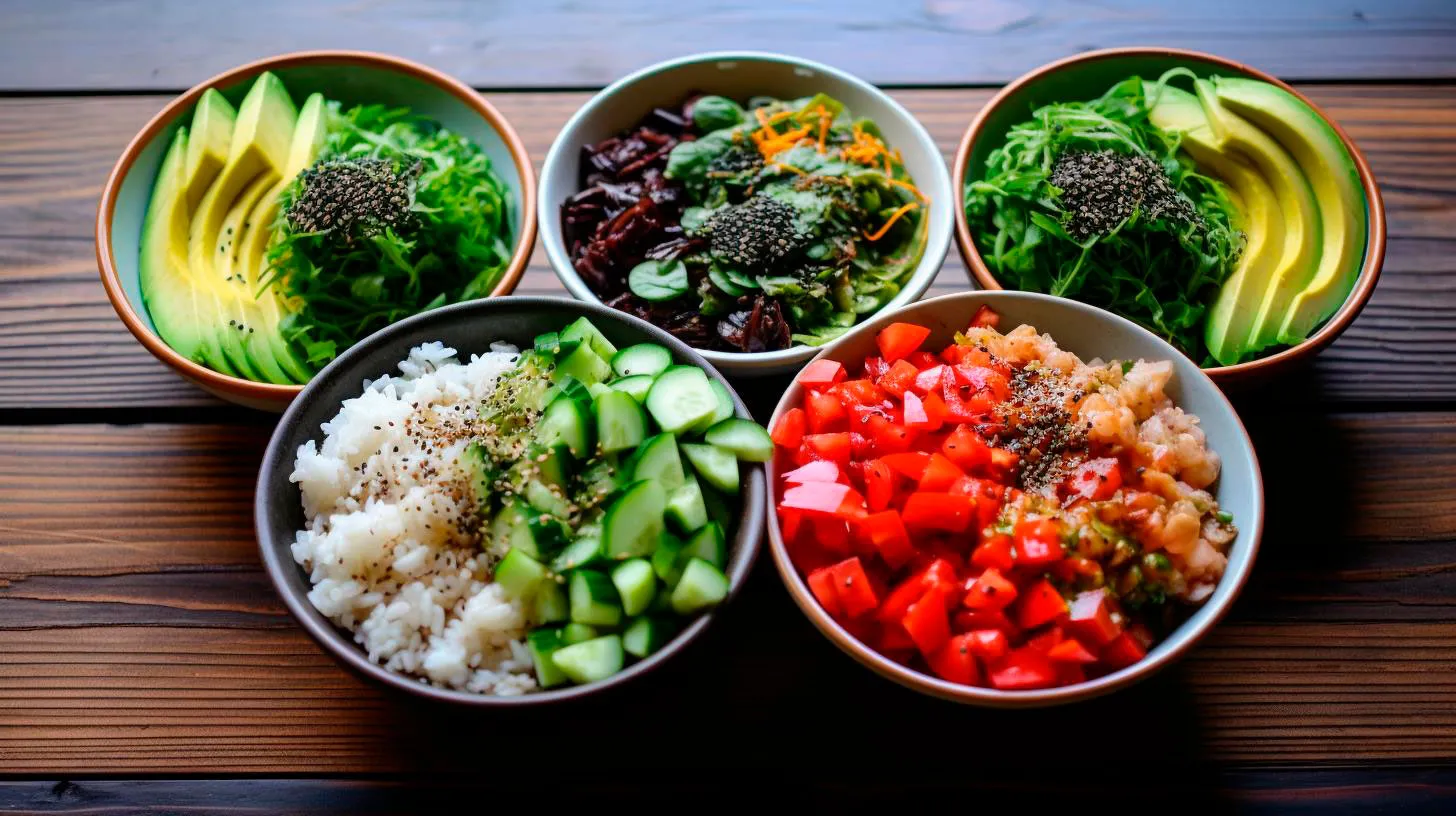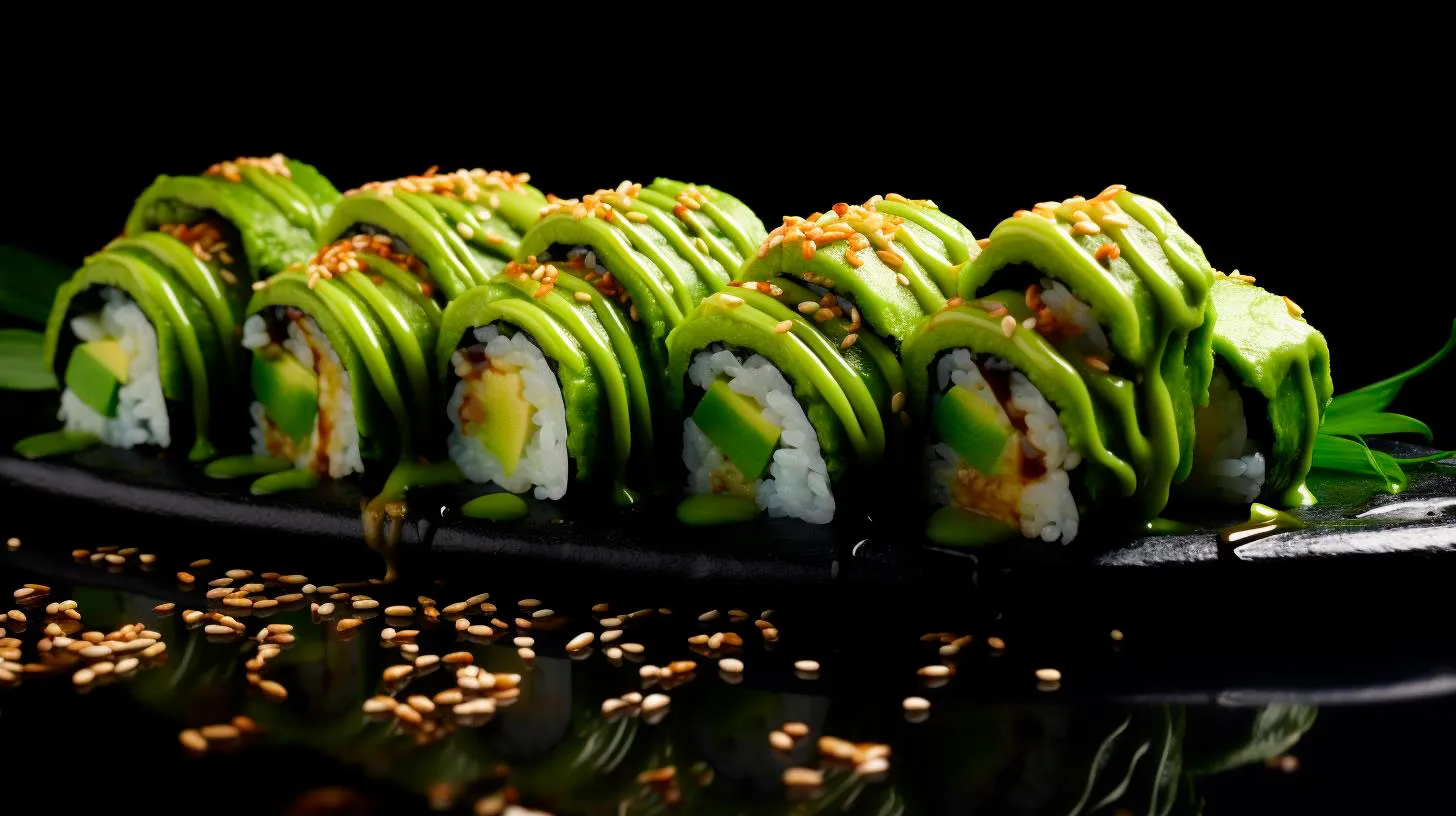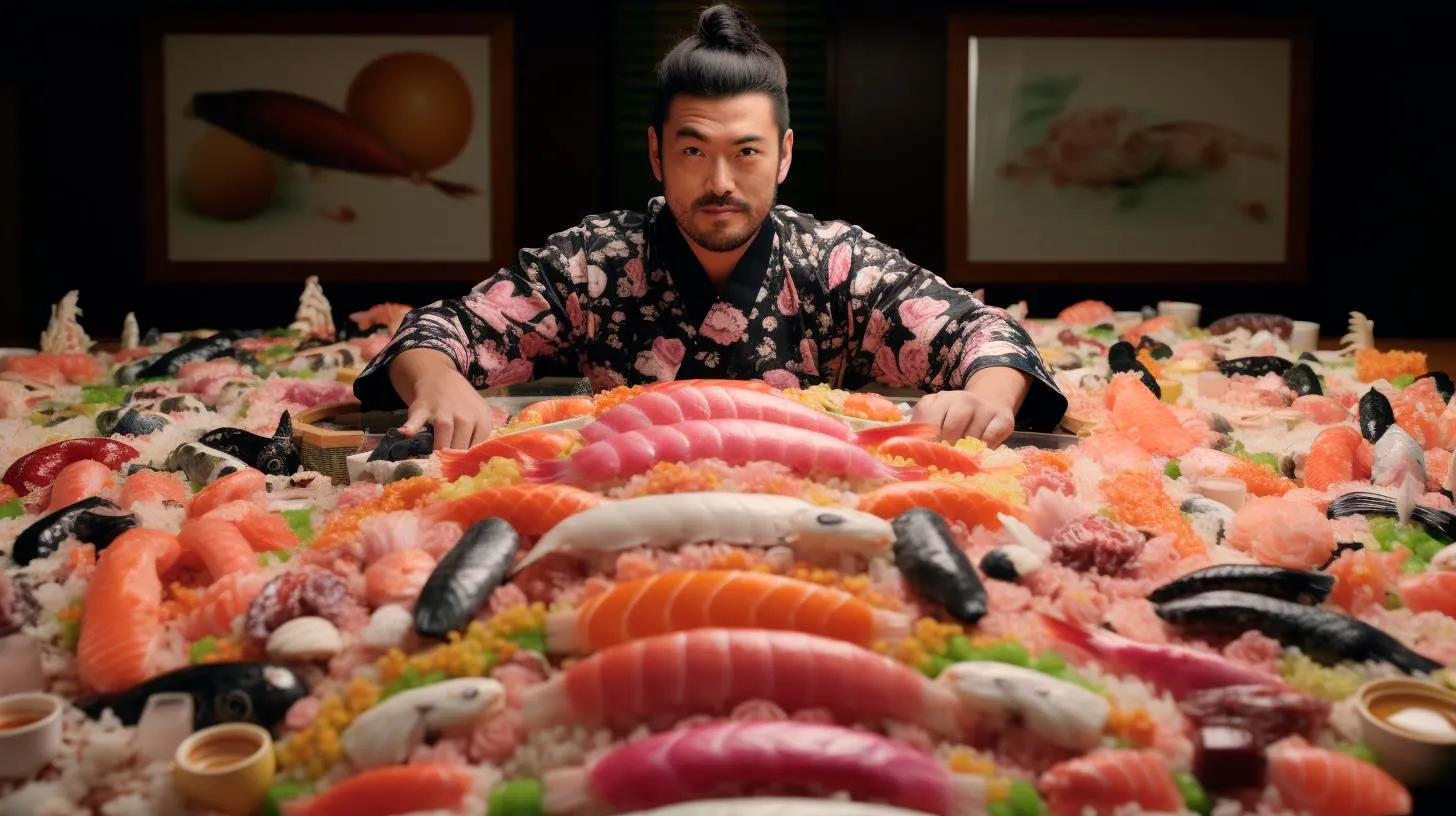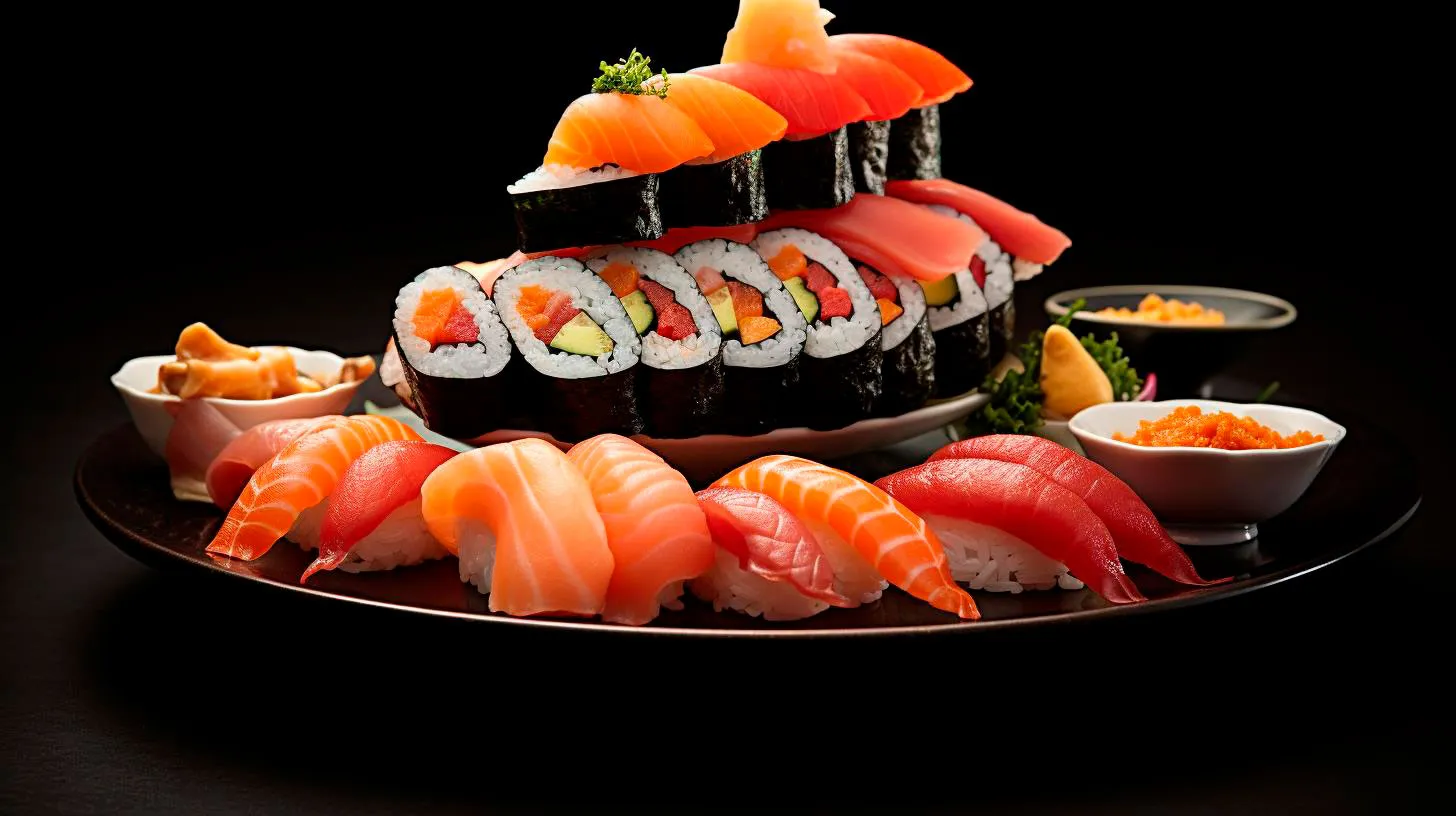Unlock the Secrets Behind Tobiko and Masago Role in Sushi Taste Enhancement
So, let’s embark on this flavorful journey and explore the wonders of tobiko and masago!
Understanding Tobiko and Masago
Tobiko and masago are types of roe, or fish eggs, commonly used in Japanese cuisine, particularly in sushi preparations. They add a burst of flavor, texture, and visual appeal to the sushi rolls we relish. While both tobiko and masago are exceptionally popular, they come from different fish species, each having its own unique characteristics.
Tobiko
Tobiko is derived from the roe of the flying fish, a staple ingredient in Japanese sushi. With its small, vibrant eggs, tobiko adds a delightful pop of color to every sushi roll. Coming in a range of hues including orange, red, black, and green, tobiko not only enhances the visual appeal but the flavor profile as well. Its subtle briny taste, combined with a hint of sweetness, complements the overall sushi experience.
Key Takeaways:
- Tobiko is derived from the roe of the flying fish.
- It comes in various vibrant colors such as orange, red, black, and green.
- The flavor of tobiko is briny with a subtle sweetness.
- It adds visual appeal and enhances the overall taste of sushi.
Masago
Masago, on the other hand, originates from the roe of the capelin, a small fish often found in the icy waters of the North Atlantic. Known for its smaller size compared to tobiko, masago brings a unique texture to sushi rolls. It has a slightly crunchy texture that adds an exciting element to each bite while still offering a delicate briny flavor.
Key Takeaways:
- Masago comes from the roe of the capelin fish.
- It offers a crunchy texture to sushi rolls.
- Similar to tobiko, masago has a delicate briny taste.
- Its smaller size makes it ideal for even distribution throughout sushi rolls.
Enhancing Sushi Flavor and Texture
Now that we have a good understanding of tobiko and masago, let’s explore how they elevate the overall taste and texture of sushi.
Flavor Enhancement
The briny and subtly sweet flavors of both tobiko and masago play a vital role in enhancing the taste of sushi. When combined with delicate slices of fresh fish, sushi rice, and other complementary ingredients, tobiko and masago create harmony by adding layers of complexity to each roll. Their flavors provide a pleasing contrast and balance that tickle the taste buds.
Textural Delight
The crunchy texture of masago contributes a delightful element to sushi rolls, creating a beautiful contrast against the soft, buttery fish and rice. Each bite becomes a symphony of diverse textures, keeping the dining experience exciting and enjoyable. Tobiko, though not as crunchy as masago, still lends a delicate pop of texture which further enhances the overall mouthfeel.
Key Takeaways:
- Tobiko and masago add layers of complexity and balance to sushi.
- Their flavors provide a pleasing contrast to other ingredients.
- Masago’s crunchy texture creates an exciting mouthfeel in each sushi bite.
- Tobiko’s small eggs offer a delicate pop of texture.
Health Benefits and Nutritional Value
Besides being delicious, tobiko and masago also offer some notable health benefits:
Rich in Omega-3 Fatty Acids
Tobiko and masago are rich sources of omega-3 fatty acids, which are known for their heart-healthy properties. Omega-3 fatty acids help lower bad cholesterol levels and reduce the risk of heart diseases, making sushi an excellent choice for those looking to indulge in a healthy meal.
Nutrient Powerhouse
Both tobiko and masago are packed with essential nutrients like vitamins B12, D, E, and selenium. These nutrients contribute to various bodily functions, including maintaining healthy bones, boosting the immune system, and promoting good overall health.
Key Takeaways:
- Tobiko and masago are rich in omega-3 fatty acids, which promote heart health.
- They contain important vitamins and minerals, including B12, D, E, and selenium.
- Incorporating tobiko and masago into your sushi can contribute to a balanced and nutritious meal.
Conclusion
Tobiko and masago, the tiny yet vibrant fish eggs, hold the key to unlocking the hidden flavors and textures in the world of sushi. From their visual appeal to the subtle brininess and delightful crunch they contribute, these ingredients have rightfully earned their place in enhancing sushi taste. So, the next time you devour your favorite sushi roll, take a moment to appreciate the unique role of tobiko and masago, and savor every bite!
Tobiko and Masago: The Perfect Sushi Flavor Boosters
Among these flavor boosters, tobiko and masago are two popular choices that add a burst of flavor, texture, and visual appeal to your sushi rolls.
Tobiko: The Tiny Gems of Delight
Tobiko refers to the roe of flying fish, which are small, orange beads that possess a distinct crunch and delightful pops of flavor. These tiny gems not only add a vibrant touch to your sushi rolls but also provide a range of flavors that complement the fish and other ingredients. Typically sourced from Japan, tobiko is harvested from various species of flying fish, including the Japanese flying fish and the South American flying fish.
Key features of tobiko:
- Vibrant orange color adds visual appeal to sushi rolls
- Offers a pleasant crunch and popping sensation
- Delivers a unique, slightly sweet and briny flavor
- Rich in omega-3 fatty acids and essential vitamins
When incorporating tobiko into your sushi, it’s important to consider the flavor combinations. Its natural sweetness and briny taste pair exceptionally well with fish such as salmon and tuna. However, it also complements other ingredients like avocado, cucumber, and even cream cheese, adding a delightful contrast in both flavor and texture.
Masago: The Burst of Flavor
Sourced from the roe of the capelin fish, masago brings its own unique elements to the sushi experience. The small, crunchy eggs have a distinct red-orange color, which adds a pop of vibrancy to any sushi roll. Masago is commonly used in Japanese and Korean cuisines, providing a burst of flavor and a satisfying crunch.
Key features of masago:
- Distinct red-orange color enhances sushi presentation
- Offers a satisfying crunch with each bite
- Brings a subtle seafood flavor with a hint of sweetness
- Rich in protein and essential nutrients
Similar to tobiko, masago pairs well with various ingredients. Its mild, slightly sweet flavor adds a pleasant contrast to rolls featuring rich, fatty fish like tuna or salmon. Additionally, masago complements ingredients like mayonnaise, spicy sauces, and sushi spices, providing a harmonious blend of flavors that keeps your taste buds wanting more.
The Advantages of Tobiko and Masago
Aside from adding visual appeal and unique flavors to sushi, tobiko and masago offer several advantages that contribute to a fulfilling culinary experience. Let’s take a look at some of these advantages:
Enhanced Textures and Mouthfeel
The crunchy texture and delightful pops offered by tobiko and masago create an exciting contrast to the softness of rice and fish. This balance of textures enhances the overall mouthfeel, making every bite a satisfying culinary adventure.
Flavor Infusion
Tobiko and masago bring additional dimensions of flavor to sushi rolls. Their slightly sweet and briny taste adds depth and complexity, transforming an ordinary sushi roll into an extraordinary treat that tantalizes the taste buds.
Visual Presentation
The vibrant colors of tobiko and masago make sushi rolls visually enticing. Whether you’re indulging in sushi at a restaurant or showcasing your culinary skills at home, these garnishes add eye-catching appeal that elevates the overall dining experience.
Nutritional Benefits
Both tobiko and masago offer nutritional benefits that contribute to a well-rounded diet. They are rich in omega-3 fatty acids, which are essential for brain health and reducing inflammation. Moreover, they are a good source of protein, vitamins, and minerals, making them a nutritious addition to your sushi rolls.
Key Takeaways
When it comes to sushi, the toppings and garnishes are just as important as the main ingredients. Tobiko and masago bring their own unique qualities to the table – vibrant colors, satisfying textures, and delightful flavors. Incorporating these flavor boosters into your sushi rolls adds a distinctive touch that impresses both visually and gastronomically. So, the next time you indulge in sushi, don’t hesitate to reach for tobiko or masago and experience the burst of flavors they bring to each delightful bite!
Add a Pop of Flavor with Tobiko and Masago in Your Sushi Creations
These small but mighty ingredients can bring an explosion of taste and texture to your favorite sushi rolls.
What is Tobiko?
Tobiko is a type of fish roe commonly found in Japanese cuisine. It is the eggs from the flying fish, which are small and brightly colored. Tobiko adds a vibrant touch to any dish, and its unique texture provides a delightful pop when you bite into it. Popular colors of tobiko include orange, red, green, and black, and each variety offers its own distinct flavor.
Key Takeaway:
Tobiko is fish roe that adds vibrant color and a delightful pop when eaten. It comes in various colors with each variety offering a unique flavor.
What is Masago?
Similar to tobiko, masago is also a type of fish roe commonly used in sushi. However, masago comes from the capelin fish and has a smaller size compared to tobiko. Masago has a slightly nutty and savory flavor that complements sushi rolls beautifully. Its vibrant reddish-orange color adds visual appeal to any dish it is sprinkled on.
Key Takeaway:
Masago is fish roe with a slightly nutty and savory flavor. It is smaller in size compared to tobiko and adds visual appeal to sushi rolls.
How to Use Tobiko and Masago in Your Sushi Creations
Tobiko and masago are versatile ingredients that can be used in various ways to enhance your sushi creations. Here are a few ideas:
- Add tobiko or masago to your favorite sushi roll for an extra burst of flavor and texture.
- Sprinkle tobiko or masago on top of a sushi roll to add a pop of color and a delightful crunch.
- Mix tobiko or masago into homemade sushi rice for a visually appealing and flavorful twist.
- Use tobiko or masago as a garnish for sushi platters or sashimi for an elegant presentation.
Key Takeaway:
Tobiko and masago can be added to sushi rolls, sprinkled on top, mixed into sushi rice, or used as a garnish for an extra burst of flavor, texture, and visual appeal.
The Benefits of Adding Tobiko and Masago
Besides the delicious flavors and added texture, tobiko and masago offer several benefits when added to your sushi creations.
- Health Benefits: Fish roe is a good source of omega-3 fatty acids, which are essential for heart and brain health.
- Visual Appeal: The vibrant colors of tobiko and masago make any dish visually appealing, making your sushi creations Instagram-worthy.
- Umami Flavor: The unique umami taste of tobiko and masago can take your sushi experience to a whole new level, enhancing the overall flavor of the dish.
- Textural Contrast: The crunchy texture of tobiko and masago provides a pleasant contrast to the softness of the sushi rice and other ingredients.
Key Takeaway:
Adding tobiko and masago to your sushi creations not only enhances flavor and texture but also provides health benefits, visual appeal, an umami taste, and textural contrast.
Industry Statistics on Sushi Consumption
Sushi has gained immense popularity worldwide in recent years. Here are a few industry statistics that highlight its widespread appeal:
- The global sushi market is expected to reach $22.8 billion by 2026, growing at a CAGR of 4.3% from 2020 to 2026.
- In the United States alone, sushi consumption increased by 28% between 2010 and 2018.
- As of 2020, Japan is the largest consumer of sushi, followed by the United States and China.
Key Takeaway:
Sushi has gained significant popularity worldwide, with the market expected to continue growing. Statistics show increased consumption in various countries, including the United States and Japan.
Final Thoughts
Tobiko and masago are small but mighty ingredients that can elevate your sushi creations to new heights. Whether you want to add a burst of flavor, vibrant colors, or unique textures, these fish roe varieties have got you covered. Experiment with different combinations and unleash your creativity to create sushi rolls that not only taste amazing but look visually stunning. So, the next time you’re craving sushi, don’t forget to add a pop of flavor with tobiko and masago!
Discover the Versatility of Tobiko and Masago in Sushi Making
These colorful roe toppings not only add a burst of flavor but also provide a visual feast for sushi lovers. In this article, we will explore the versatility of tobiko and masago in sushi making, their unique characteristics, and how they can elevate your sushi experience.
The Delicate and Crunchy Tobiko
Tobiko refers to the roe of the flying fish, which is native to the waters of Japan. It is known for its tiny, vibrant eggs that come in various colors such as orange, black, yellow, and red. The texture of tobiko is delicate and crunchy, which provides a satisfying popping sensation when bitten into. This gives an interesting contrast to the softness of the sushi rice and other ingredients. Here are some key points about tobiko:
- Tobiko adds a delightful crunch to sushi rolls, enhancing the overall texture of the dish.
- It has a distinctive taste, slightly sweet and briny, which complements the flavors of other sushi ingredients.
- Tobiko is rich in omega-3 fatty acids, which are beneficial for heart health.
- The vibrant colors of tobiko make sushi visually appealing, creating an appetizing presentation.
The Versatile Masago
Masago, on the other hand, refers to the roe of the capelin fish, which is found in the Arctic and Atlantic oceans. It has smaller eggs compared to tobiko and comes in shades of red and orange. Masago is incredibly versatile and can be used in a variety of sushi preparations. Here are some notable features of masago:
- With its smaller size, masago provides a subtle burst of flavor that spreads evenly throughout the sushi roll.
- Its mild and slightly salty taste makes it an excellent complement to many sushi ingredients.
- Masago adds an appealing pop of color to sushi, making it visually appealing and appetizing.
- The small eggs of masago create a pleasing texture, enhancing the overall sushi experience.
Ways to Incorporate Tobiko and Masago in Sushi
Now that we have explored the distinct qualities of tobiko and masago, let’s discuss some popular ways to incorporate them into your sushi creations:
Nigiri Sushi
Tobiko and masago can be used as a topping for nigiri sushi, which consists of a slice of raw fish or seafood placed on a small bed of sushi rice. The vibrant colors of tobiko and masago create an eye-catching presentation, making each piece of sushi visually appealing.
Sushi Rolls
The crunchy texture and unique flavor of tobiko make it an excellent ingredient for sushi rolls. It can be sprinkled on top of the roll or used as a filling, adding a burst of color and enhancing the overall taste and texture. Masago, with its smaller eggs, blends well with other ingredients and can be used in various rolls.
Sashimi Garnish
Tobiko and masago can also be used as a garnish for sashimi. The vibrant colors and crunchy texture of tobiko create a beautiful contrast against the smooth slices of raw fish, making it a feast for both the eyes and taste buds.
In Conclusion
Tobiko and masago are two ingredients that have gained notable popularity in sushi making. Their unique qualities, including the delicate crunch of tobiko and the subtle burst of flavor from masago, add depth and excitement to sushi creations. Whether used as toppings for nigiri sushi, incorporated into sushi rolls, or used as sashimi garnish, these roe toppings are sure to elevate your sushi experience with their vibrant colors and delicious taste. So next time you visit a sushi restaurant or try your hand at making sushi at home, don’t forget to explore the versatility of tobiko and masago!



